Glocks are popular handguns because they are reliable and perform well and they are also easy to upgrade and customize. That last item is handy because one of the most-complained-about characteristics of Glocks are their triggers. A Glock trigger is striker-fired, not hammer-fired, like in a 1911, Beretta 92, SIG P226, and others. The trigger in striker-fired pistols basically slingshots the firing pin into the pistol-cartridge primer. A trigger on a hammer-fired pistol trips the hammer, which then pounds the firing pin into the pistol-cartridge primer. These are very different systems and offer distinct and very different trigger presses when shooting.
So how does a Glock trigger work? As the trigger is pressed, the cruciform, a cross-shaped piece on the end of the trigger bar, pulls the firing-pin back, creating tension on the firing-pin spring. This is that spongy feeling in the trigger. On Glocks, the firing pin is semi-cocked, with about 50% tension on the spring. This is part of the safety features built into the Glock. Other striker-fire pistols, such as the FN 509 series and the Springfield Armory XD series, for instance, have more pre-tension on the firing-pin spring — up to 90% — so there is less felt trigger pull. As the trigger press continues with the Glock, the trigger bar engages the connector, which causes the trigger bar to drop and release the firing pin to fire the round.
Talking Triggers
Before we get any deeper in the weeds about trigger replacement, we should clarify some trigger terms so we’re talking the same language. Here’s a quick glossary:
Trigger Take Up: The distance the trigger travels before hitting resistance. Take up is also referred to as pre-travel or slack.
Trigger Wall: The point after trigger take up when the shooter feels resistance from the trigger.
Trigger Break: Past the trigger wall, the trigger will release the firing pin at a specific point, causing the gun to fire. That point of release is called the break. The trigger break can be further described in good or ill terms. A crisp or clean trigger break means the trigger breaks quickly. A trigger that does not break cleanly is referred to as mushy or spongy.
Trigger Overtravel: A term given to the distance the trigger travels after it breaks. A good trigger will stop moving immediately after the break, with minimum overtravel.
Trigger Reset: Comes after the shot breaks and the user relaxes the trigger finger to allow the trigger to move forward and reset for the next shot. The preference is for short reset because this allows for faster follow-up shots.
Improving on OEM
Numerous manufacturers have made it their business to provide shooters with aftermarket triggers for Glocks that improve upon the OEM Glock trigger. Most of these aftermarket triggers follow the Glock design, meaning they use a cruciform to pull back the firing pin. Also common to all of these drop-in triggers are highly polished contact surfaces and slightly modified trigger bars where the trigger bar contacts the connector. What is different with most of these are their trigger shape and geometry.
If your goal is to reduce the pull weight of the Glock trigger, you will need to swap out the connector and change some springs. The goal of our test was to use stock Glock parts and only swap out the trigger and evaluate the differences.
The OverWatch Precision TAC trigger, Apex Action Enhancement Trigger, and Timney Alpha Competition Series trigger are popular examples of aftermarket triggers. These manufacturers also produce aftermarket triggers for S&W, FN, Springfield Armory, SIG, CZ and others.
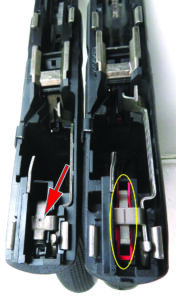
OverWatch and Apex triggers are very similar to the factory Glock trigger in that they preload the striker about 50 percent. The Timney trigger is different in that it completely loads tension on the firing mechanism so you don’t feel that spongy creep during the trigger press. The Timney trigger does this by adding a sear assembly that is inserted into the stock Glock trigger housing. Timney really thought out of the box on their aftermarket Glock trigger, and it is unique in the market.
Glock drop-in triggers are aftermarket items that replace the stock trigger and drop in place of the OEM trigger. There is no fitting required and no special skill required to install a Glock drop-in trigger. Typically, the only tool a shooter needs to install one of these triggers is a Glock armorer’s tool or a pin punch.
To start an install, make sure your magazine is unloaded and out of the handgun, and that the chamber is clear of any ammunition. Then, field-strip your Glock and push out three pins: 1) the locking block pin; 2) the trigger housing pin; and 3) the trigger pin.
For the Apex and OverWatch units, the process of replacing the trigger and trigger bar is very easy and takes longer to describe than perform. With the Timney, there are a few extra steps. Namely, inserting the sear into the Glock trigger housing. All very simple to perform. In fact, Timney provides easy-to-follow step-by-step instructions. Our lawyers told us to tell you to go to the OverWatch, Apex, and Timney websites for complete details on how to install the triggers.
Glock G17 Gen3 OEM Trigger
Gun Tests Grade: A-
$14
We have learned to shoot Glock OEM triggers pretty well. There is more trigger distance and more take up in the factory triggers, but their reset is shorter.
| Trigger Type | Curved smooth face |
| Trigger Span | 2.88 in. |
| Trigger Take-Up | 0.18 in. |
| Trigger Overtravel | 0 in. |
| Trigger Reset | 0.10 in. |
| Trigger Pull Weight | 5.5 lbs. |
| Warranty | Lifetime |
| Made In | U.S.A. |
| Website | Glockstore.com |
Glock G19 Gen4 OEM Trigger
Gun Tests Grade: B+
$14
Every shooter has to make the choice to upgrade his trigger or not. Some won’t, and they’ll have a serviceable, but not great, trigger.
| Trigger Type | Curved serrated face |
| Trigger Span | 2.78 in. |
| Trigger Take-Up | 0.15 in. |
| Trigger Overtravel | 0 in. |
| Trigger Reset | 0.13 in. |
| Trigger Pull Weight | 5.8 lbs. |
| Warranty | Lifetime |
| Made In | U.S.A. |
| Website | Glockstore.com |
How We Tested
We used a stock Glock G19 Gen4 for the Timney and OverWatch triggers and a Glock G17 Gen3 for the Apex. First, we looked at the ease of installation. The Timney is slightly more complicated, but Timney provides all the tools needed. Total time to install a trigger was about 10 minutes.
We also looked at trigger pre-travel, trigger reset, trigger break, and trigger pull weight. While these data points can be measured, they are also subjective depending on who is pulling the trigger. We initially tested the triggers by dry-firing them using the Mantis X3 Shooting Performance system ($170; MantisX.com). This dry-fire system attaches to your pistol via the accessory rail and collects a ton of data. For instance, it tracks the movement of the gun barrel during the trigger press. It then tracks the shot fired and provides advice on how to improve your score, i.e.; are you are slapping the trigger, or tightening your grip. It also provides a graphical trace with color codes. The blue line is aiming, yellow line is trigger pull, and red line is shot breaking. We thought the Mantis system could provide objective insights for each trigger in use. We also used the stock Glock OEM triggers as a baseline. And, naturally, we used live fire to see how the triggers performed in slow and rapid fire. For live fire, we performed Failure Drills — two fast shots to the body, and one precision shot to the head.
Before going to live fire, we used the Mantis to perform two drills, a Compressed Surprise Break and the other was a Benchmark exercise. With the Compressed Surprise Break, the goal is to learn to press the trigger quickly. This is a five-shot drill that is timed.
The shooter starts with the firearm on target and fire one shot as quickly as possible after the start buzzer sounds. The Benchmark measures precision and performance over time. The shooter takes 10 shots with no time limit and try to fire a precise shot each time.
With all these measurements in our pocket, did we wind up liking one trigger over the other? Oh yes. We feel the OverWatch TAC trigger and the Apex Action Enhancement Trigger are fine additions to your EDC and home defense guns because they are measurably better than the Glock OEM trigger. The Timney Alpha Competition trigger transforms the Glock into a pistol more suitable for range work by reducing the pull weight to a little more than 4 pounds. We think 4 pounds is too light for an EDC gun, so we’d pass on using it for self defense, either out in the world or at home. Interestingly, we found we could shoot the G19 Gen4 trigger better than the G17 Gen3 trigger. Here is what else we found when we took these accessories to the shooting range:
Apex Enhancement Trigger & Trigger Bar
Gun Tests Grade: A-
$100
The flat-face trigger and safety lever were easy to press. Very smooth, with a very short reset. The trigger pull was slightly reduced and so smooth, it felt lighter. Came in last in all the drills.
| Trigger Type | Flat smooth face |
|---|---|
| Trigger Span | 2.98 in. |
| Trigger Take-Up | 0.17 in. |
| Trigger Overtravel | 0 in. |
| Trigger Reset | 0.09 in. |
| Trigger Pull Weight | 5.2 lbs. |
| Warranty | Limited lifetime |
| Made In | U.S.A. |
| Website | ApexTactical.comApexTactical.com |
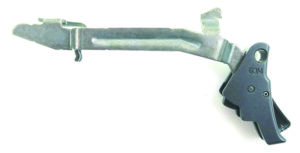
The Apex trigger is a polymer flat-face trigger with a built-in safety lever. The spring on the safety lever was very light, so it was much easier to press the safety lever in. The flat-faced trigger made a more comfortable and ergonomic shooting experience compared to the OEM trigger. The shooter can index his feel of the trigger using a tip at the end of the trigger.
We noticed a different trigger experience right away. Even though there was slightly more trigger span than the OEM trigger, due to the trigger shape and smooth pull, we did not think it was a liability. We thought this trigger was very smooth to press and has a very short reset.
There is a distinct audible click and feel in the trigger on reset. The trigger-pull weight was slightly reduced to 5.2 pounds compared to the factory pull weight of 5.5 pounds, but because the trigger was so smooth, the pull weight felt lighter. That tells us the ergonomics of the trigger are well designed. Hitting the wall was very consistent, and the break was the merge between crisp and mush, but more on the crisp side.
Going hot, we found it easier to perform the Failure Drill with the Apex trigger than the OEM trigger. Our double taps were fast and on target, and the third A-Zone shot could be fired with precision.
Our Team Said: The Apex trigger performed well, and at less than $100, we feel this is a Best Buy. If you want to get into a flat-face trigger but not spend a lot of money, we recommend you try the Apex Enhancement trigger.
OverWatch Precision TAC Trigger
Gun Tests Grade: A-
$135
We liked the flat-face OverWatch TAC trigger. Our average score on the Compressed Surprise Break and Benchmark drills was second among the aftermarket triggers.
| Trigger Type | Flat face |
|---|---|
| Trigger Span | 2.76 in. |
| Trigger Take-Up | 0.13 in. |
| Trigger Overtravel | 0 in. |
| Trigger Reset | 0.17 in. |
| Trigger Pull Weight | 4.9 lbs. |
| Warranty | Lifetime |
| Made In | U.S.A. |
| Website | OverwatchPrecision.com |
The TAC trigger uses an OEM-style trigger bar that is NP3 plated, which is a fancy way of saying the part has a Teflon coating. The trigger itself is machined out of 7075-T6 aluminum alloy. OEM Glock triggers are polymer. The OverWatch trigger is flat faced. The OEM Glock trigger is curved. The trigger style is mostly a personal preference, but there are advantages to both flat and curved triggers. With a flat-face trigger, the trigger finger makes more uniform contact with the trigger, meaning a flat trigger ensures the trigger-pull length is uniform, no matter where the trigger finger makes contact with the trigger.
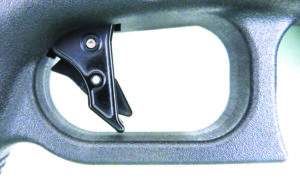
Conversely, the advantage of a curved trigger is reach. The distance from the grip back strap to the trigger face is less in the middle of the trigger blade than at the top or the bottom of the trigger. With a curved trigger, our finger naturally finds the center of the trigger blade. The idea is, you want consistency in trigger-finger placement on the trigger, and a flat trigger increases consistency of trigger-finger placement. The TAC also has a small indexing hook at the tip to ensure consistent trigger-finger placement. It also has a safety tab built into the trigger face similar to an OEM trigger, and it does not disable any safeties.
In dry-fire exercises, some testers found they were more consistent and more accurate when they gave the trigger more knuckle, meaning they pressed the trigger with the first knuckle of the finger against the trigger in lieu of using the finger pad. The trigger face itself was broad and flat and allowed a straight rearward press, even if our trigger-finger placement on the trigger was exact.
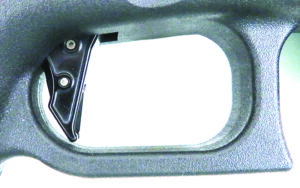
We found in live fire that we were quick with the TAC trigger. Our finger placement was more consistent, but the pull weight and a slight spongy feeling remained. It did get slicker after use and that is a function of the trigger bar and connector rubbing against each other. We did find that the OverWatch reduced the overall trigger travel, which means in theory a user could fire the pistol faster. Hitting the wall after pre-travel was consistent. With reset we heard a distinct audible click and felt it in the trigger. And we did shoot fast and accurately with it. Pull weight decreased by almost 1 pound.
Our Team Said: We liked this trigger and feel it is a good investment. We fired our best averages and time with this trigger compared to the Apex trigger.
Timney Alpha Competition Series Alpha Glock 3-4
Gun Tests Grade: A
$150
We think this trigger would be a good upgrade for a competition or target gun. The trigger pull is little too light for EDC, in our opinion. Still, the Timney averaged the highest scores in all the drills.
| Trigger Type | Flat face |
|---|---|
| Trigger Span | 2.85 in. |
| Trigger Take-Up | 0.10 in. |
| Trigger Overtravel | 0 in. (adjustable) |
| Trigger Reset | 0.04 in. |
| Trigger Pull Weight | 4.5 lbs. |
| Warranty | Lifetime |
| Made In | U.S.A. |
| Website | TimneyTriggers.com |
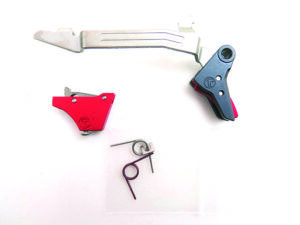
Hands down, the Timney trigger makes it a bit easier to shoot the Glock, in our opinion. The Timney trigger is flat faced with the safety lever built into the center. There is no tip at the end of the trigger like with the Apex and OverWatch. The trigger is made of aluminum, and the trigger bar is Teflon nickel coated, also called NP3 coating, so it is slick and will smooth up with use. The kit contains a trigger and trigger bar, sear assembly, two trigger return springs — one for stock Glock parts and one for aftermarket parts — and the tools to install the trigger.
Our best average score out of all the triggers was with the Timney, with a Benchmark score of 95.5. The fastest trigger Compression Surprise Break came with the Timney, too, at 0.30 seconds. The Alpha’s trigger pull at 4.5 pounds was the lightest out of all of the triggers tested.
After about 0.10 inches of take-up, we hit the wall and from there, the break was crisp. The Timney had the cleanest break of all the triggers. The reset was not as strong as with the other triggers, but it was a very short reset, which measured 0.04 inch.
We found it easiest to use the Timney trigger for the Failure Drill. Our initial shots were very fast, and due to the trigger, the third shot in the drill was more often in the A zone than not.
Our Team Said: The trigger reminded us of a 1911-style trigger with a stout wall before the break. In our opinion, this is an excellent trigger for a competition Glock. We feel the pull weight is a bit too light for EDC, but despite our warning, we are sure these triggers will find their way into many EDC Glocks.



























Would you please publish a second article with diagrams and/or cut-away views showing the action
of what happens to the cruciform, trigger bar, etc. I tried to picture what was going on from your text and couldn’t develope a mental picture. Rats. (I shoot a Sig P226.)
Thanks for the clear, informative, & enjoyable article on Glock aftermarket triggers. I own a Glock, but haven’t yet modified the trigger. With this article in hand, I feel perfectly confident to select one. Since liability is probably the same once a person alters the factory trigger, the author’s caution notwithstanding, I’d go for the Alpha lighter trigger.
Excellent review, well done sir. And while not eact for other firearms of course, it does serve as a sort of ‘primer’ for some aspects of aftermarket trigger selection in general.
Thanks!